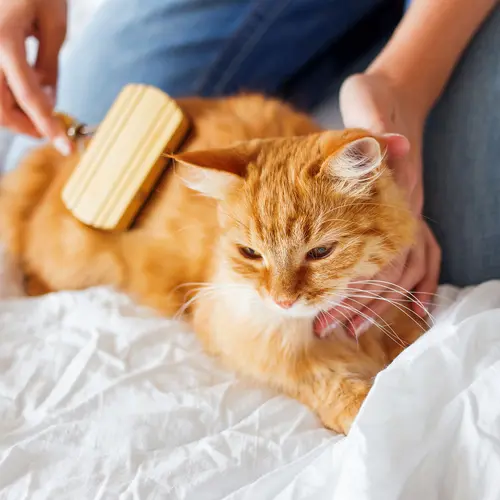Feline distemper, also known as feline panleukopenia virus (FPV) or feline parvo, is a devastating and sometimes fatal disease that occurs in cats. It has also been called cat fever, cat plague, feline agranulocytosis, and feline infectious enteritis.
Regardless of what you call it, though, it is a highly contagious disease spread among cats and found practically everywhere in the environment. Cats are more susceptible to contracting the virus, though, if they are based in communities such as kennels, animal shelters, pet stores, and feral cat communities.
While all cats are at risk for contracting FPV, young kittens, immunocompromised cats, and unvaccinated cats are at greater risk. They can also be more severely affected.
This disease affects the intestinal lining and white blood cells. While it is life-threatening, cats who survive will become immune to a subsequent infection.
The number of deaths related to feline distemper has decreased over the years, thanks to advancements in veterinary medicine and effective vaccinations. However, this disease was once a leading cause of feline death, and the effects can still be seen devastating unvaccinated cats, which is why it’s critical to vaccinate yours.
Feline distemper was the first virus-caused disease diagnosed in cats, and the parvovirus that causes feline distemper can survive for up to a year in an environment. This virus does not affect people, though.
Feline Distemper Causes
Feline parvovirus is the primary panleukopenia cause. Once infected, a cat can infect other cats who come into contact with its blood, urine, or feces. Additionally, fleas can carry the disease from an infected cat to another unvaccinated cat. Humans can also transmit the disease if they handle an infected cat and then come into contact with an unvaccinated cat prior to washing their hands or changing their clothes.
Typically, an infected cat will spread the virus for up to two days after infection. However, even after the carrier is no longer contagious, the virus can survive on surfaces for a long time and is unaffected by many household cleaners, except bleach.
Unvaccinated cats who come into contact with contaminated surfaces, such as bedding, cages, food dishes, litter boxes, and other surfaces, are at risk of contracting the virus, even if they don’t come into contact with an infected cat. For this reason, an unvaccinated cat should be kept away from areas where an infected cat has been.
Feline Distemper Symptoms
Feline distemper can be mistaken for other illnesses. Additionally, cats are good at hiding when they’re feeling unwell, so symptoms may not present themselves right away.
However, you may eventually notice that your cat is not as energetic as they once were. They may seem depressed and present a high fever, vomiting, severe diarrhea, and nasal discharge.
Other symptoms include:
- Anemia
- Rough coat
- Loss of appetite
- Bloody diarrhea
- Dehydration
Additionally, your cat may seem uncoordinated, and they may display odd behaviors such as hiding from you and resting their chin on the floor.
Diagnosing Feline Distemper
Diagnosing feline distemper is sometimes difficult. The symptoms are often confused for symptoms of pancreatitis, poisoning, and other illnesses. Due to the extreme nature of feline distemper, though, it’s important that it’s properly diagnosed.
Your veterinarian will ask for a complete history of your pet’s health and how the symptoms have manifested. They may also ask for samples of bodily fluids.
A blood test will be conducted on your cat to determine how many white blood cell types are present. Reduced white blood cells may point to a feline distemper infection.
Other diagnostic tests may include:
- IDEXX SNAP test
- Blood smear
- Necropsy
- Biochemical profiling
Feline Distemper Treatment
Currently, there is no cure for feline distemper or specific treatments for this disease. However, you and your veterinarian can provide care to increase your cat’s chances of survival and combat the most life-threatening complications, such as dehydration. Treatment should begin within 48 hours of infection. Since feline distemper can lead to infections developing in your cat, your veterinarian may prescribe antibiotics.
Affected cats who do not receive treatment typically die from dehydration or secondary infections.
An Ounce of Prevention
Of course, even if it’s possible for a cat to survive a feline distemper infection with the right treatment, it’s better to prevent your cat from contracting the disease to begin with. Due to the variability, the vaccinations should begin with an initial round at 6 to 8 weeks of age. Repeated vaccines are necessary every 3 to 4 weeks, or 2 to 3 weeks in shelters, until they reach the age of 16 to 20 weeks. However, some countries have regulations where vaccination use is only licensed for kittens over 8 to 9 weeks old.
Cats who are currently being treated for feline distemper should be isolated from other cats, and this isolation should last for several weeks. Their food, water, and litter box should all be kept close by and easily accessible. Your cat will need to be showered with affection during this time, especially since they will be isolated from the rest of the house. After tending to your cat, though, be sure to wash your hands thoroughly and change your clothes.
If you’ve had a cat who was infected with feline distemper and plan to introduce another kitten to your home, you’re advised to clean your home thoroughly with products that are able to eliminate any parvovirus (like bleach). You may even want to clean your house again in two weeks to ensure that nothing was missed.

